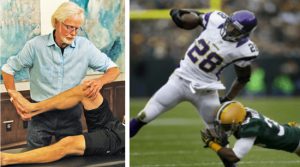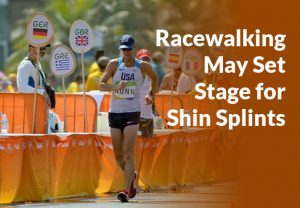Homolateral gait, righting reflexes, and neck strain
By Erik Dalton
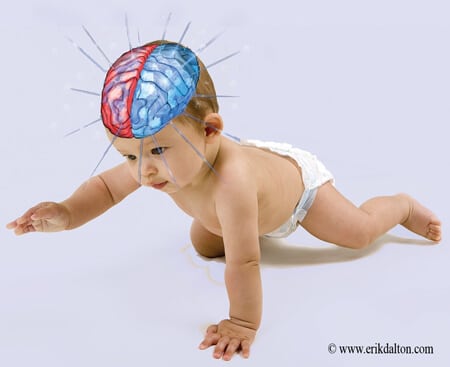
Before an infant learns to crawl, he moves using homolateral movements, which involve one side of the body, such as the right hand and leg, jutting forward simultaneously during reaching and kicking activities. Throughout this primitive developmental stage, the right cerebral hemisphere controls the child’s right side, and the left hemisphere controls the left. The resulting uncoordinated movement continues until he begins to cross-crawl. This new contralateral movement pattern then reorganizes his central nervous system so all bodily systems work together as a team (Image 1). Here are some signs cross-patterned movements could use sharpening: poor balance, neck stiffness, lack of coordination, difficulty reading, stuttering, clumsiness, and learning disabilities such as dyslexia.
In certain people, a smooth cross-patterned gait simply failed to develop, partially due to well-meaning parents who prematurely encouraged the child to move from crawling to walking before a strong neurological bridge through the corpus callosum had been established. In others, things like traumatic injuries, bracing, prolonged inactivity, and lumbar fusion surgeries have shocked the body and jumbled nerve impulses, causing the brain to revert back to a previously mapped homolateral pattern. Clients presenting with remnants of homolateral gait not only need cross-crawling home retraining exercises to help strengthen whole-brain neuronal connections, but also good bodywork to correct compensatory muscle imbalance patterns that have formed.
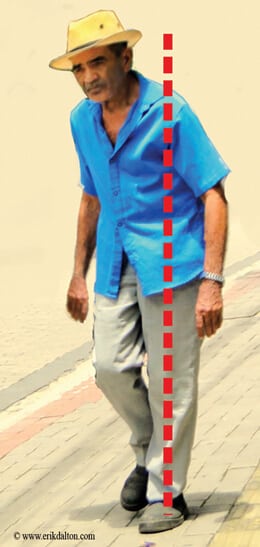
During gait evaluation, we occasionally see clients sporting homolateral remnants that cause them to walk in a block-like fashion, with the shoulder girdle and pelvis rotating as one unit. Notice in Image 2, how this gentleman’s homolateral pattern forces him to right sidebend his head as he bears weight on his left leg. This unbalanced position not only unlevels his eyes, but produces excessive energy expenditure, due to altered head over leg positioning. Unleveling of his eyes triggers head-righting reflexes that set the stage for whole-body stress and cervicogenic strain.
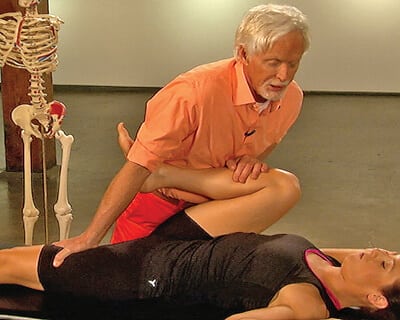
Is balance the key to ideal posture?
One of the evolutionary advantages of erect posture is that it establishes ease of head rotation around the vertical axis, which serves to widen one’s horizon. In early man, the need to stabilize this sensory platform to track a target was essential for survival. Optimal head-on-neck positioning should allow easy access in all directions, limited only by skeletal architecture rather than any muscular impediment from protective muscle guarding. A walk that does not land in balance forces the body’s posture to compensate via muscular contraction, particularly in the cervical spine.
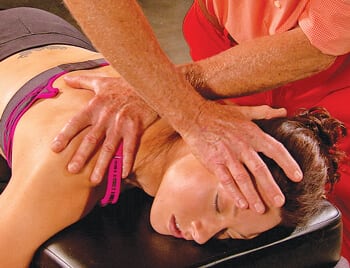
Balance is greatly enhanced when the head is vertically aligned with the stance foot, eyes looking straight ahead. This cervicocranial positioning allows gravitational forces to transmit effortlessly through the body.
Before offering cross-patterned home retraining exercises such as the ones outlined below, therapists must first make sure all kinetic-chain kinks are removed, and the neck, thorax, lumbar spine, and pelvis are able to sidebend and rotate symmetrically to encourage a smooth cross-patterned gait. Images 3-5 offer technique suggestions for dealing with the type of protective compensatory spasm I see in many of my homolateral-patterned clients.
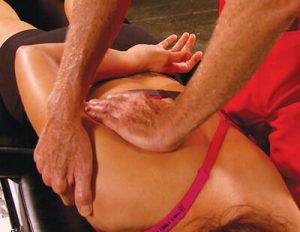
Summary
Infancy is characterized by clumsy, non-optimized homolateral motor behavior and, along these same lines, less integrated cognitive function. As a child grows and develops, mastery of cross-patterned movement allows bodily systems to begin working together as one seamless team. As adults, practicing contralateral movements is a prime way to practice self-care. In fact, cross-lateral exercise can be one of the most fun and effective ways to reboot your nervous system, help discharge stress, and recharge your attention and energy.
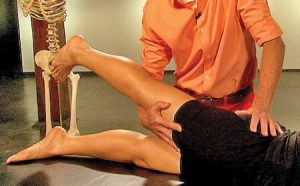
Cross-Lateral Exercise
Try this cross-lateral exercise at work: Stand with your feet apart and your arms open parallel to the ground. Shift your weight to your right foot, then lift your left knee and touch it with your right hand. Step back to both feet, then immediately shift weight to your left foot as you lift your right knee and touch it with your left hand. Repeat this several times in a comfortable, upbeat, rhythmic way. If the situation allows, get down on the floor and practice cross crawling. Such cross-lateral exercise provides a fantastic break from mentally over-focusing and can serve as a handy neurological tool to help bring both body and mind back online.
On sale this week only!
Save 25% off the "Dalton Technique Treasures" eCourse
The “Dalton Technique Treasures” eLearning course is a compilation of some of Erik’s favorite Myoskeletal Alignment Techniques (MAT). Learn MAT techniques to assess and address specific sports injuries, structural misalignment, nervous system overload, and overuse conditions. ON SALE UNTIL July 29th! Get Lifetime Access: As in all our eLearning courses, you get easy access to the course online and there is no expiry date.





